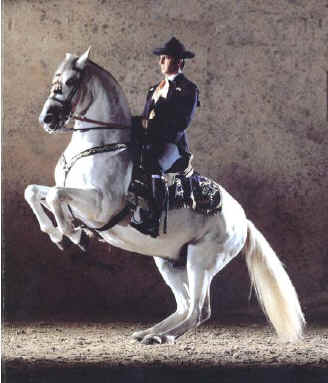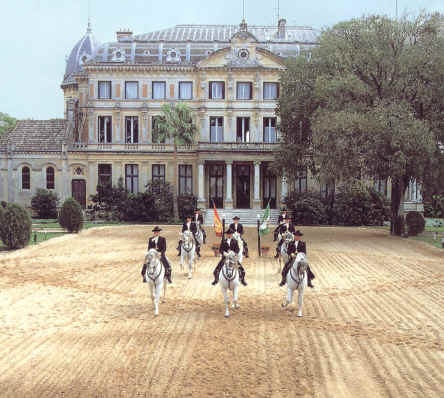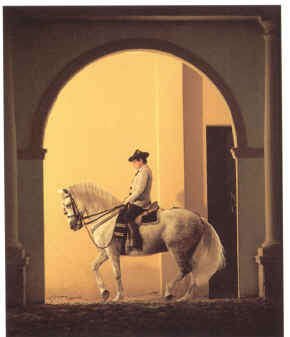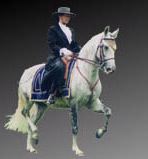|
Home
Schooling
Classical dressage
Modern dressage
Horse trials
Show jumping
Glossary
Links
|
Lesson written and edited by Roger
From notes by Joanna Batista
This is a most difficult lesson to write. The reason I
have found this subject to be so tough to express in words is that the
techniques and the methods of influencing your horse with your seat, balance and
posture is so complex and deep that it is sometimes bordering on the spiritual.
You must have the ability to totally concentrate on what is happening between
you and your horse, to completely disregard and reject outside influence and be
able to go into a meditative state.
The American classical dressage rider Paul Belasik
found his way through this minefield by using eastern martial art techniques. I
would highly recommend his book "Riding Towards The Light" to get his
perspective. Paul and I had long talks late into the night about this subject, polishing off
several bottles of good malt whisky in the process I might add, and it become clear to me
that there was no easy way to express the
techniques involved in one easy sentence, or lesson. It's a feel, a way of
thinking. A total belief in one's own ability, and a completely open mind and
ability to listen to your horse's body language and what your horse is saying
to you.
A few weeks ago Richard Maxwell, the specialist in
equine behavioral problems visited my yard to try and sort out an Arab mare that
the owner was having problems with. Richard's time had been bought by the
client's husband so he came to Aberdeen to see this one horse. He started work
on the horse at about 9 o'clock that morning and worked on the horse for about
three hours. After the session, which was most successful I might add Richard
came into the house for a cup of coffee before he had to leave for his next
appointment in Glasgow. Five hours later we were still talking.
It became clear that everything Richard did with the horse on the ground and in
the saddle, with just a head collar, was exactly the same as riding the classical
way. There was absolutely no difference. The main message to come from this
discussion was "listen to what the horse is telling you", "have an open mind and try to interpret the equine language into human understanding". "Force is a barrier
to understanding". In the classical seat, the classical way of riding, the
messages are the same.
Because I was finding this lesson difficult to write I
enlisted the help of Joanna Batista.
Joanna trained at the Spanish School of Equestrian Art
and runs her own classical dressage training stables near Seville in Spain. She
has visited The Grove Riding Centre here in Aberdeen on several occasions and I
can think of no one who is more qualified to teach the classical seat.

I have watched Joanna work on horses here in Aberdeen
and I found it astonishing the amount of communication and responsiveness she
can get from a horse just by sitting and walking the horse forward. Not using
her legs at all, just using her seat. Joanna will be the first to admit that
watching her work is not the most exciting way to spend your time. It's like
watching paint dry or snow melt. From the outside, from the observer's point
of view, nothing appears to be happening. The magic comes when Joanna trots the
horse forward and he is immediately light in the hand, up off his forehand,
working through his back and engaging his hind quarters far more than has ever
been achieved before. I have ridden a very stiff backed horse straight after
Joanna has set the horse up and I assure you, it was magic.
Everybody can play the piano. Anybody can bash away at
the keyboard and make a noise. It's getting the notes in the right order that
makes the music. To a certain extent riding your horse the classical way is the
same. Most people, unless they are terrified of horses, have lousy balance or
have some physical disability, are able to ride a horse. To ride the classical
way however takes a little longer and a degree of learning and dedication to get
the notes in the right order.

Think of your training sessions as you would if
you were playing scales on a musical instrument. The scales, the exercises, are
preparing you the musician / the rider for the symphony or the dressage test or
demonstration you will play or ride in the future. What is the difference
between a normal musician and a talented or gifted musician? Both can play the same notes, in the
same order, but the gifted, talented musician, can make the music soar, be so beautiful that the
difference between the two artists and the music they have just played can be
easily heard.
How is this done? Who knows, but if you asked the talented
musician how he does it, he will probably say that he "feels" the music. He
has some sort of higher level of understanding as to what the composer was
trying to express in his musical score.
The Classical Seat: What Is It?
It is a way where a rider (on horseback) can:
- Ride with pleasure.
It teaches one to act / maneuver with ease and balance
(no tension / stiffness in any part of the body).
When one has mastered these techniques, no force will be needed to ride your
horse. You will influence your horse with balance, mutual understanding of the
equine / human language, and because you are in harmony with the horse, it
appears that you are doing nothing to influence the way your horse is moving
across the ground. Work on the lunge to really understand balance and become
relaxed.
- Be effective with minimum energy and action.
No pulling, no kicking. Never fight or force the horse to respond to an aid. The
horse will willingly do what you ask because it will be what he wants as well.
Unlike most human beings, horses by nature are quite happy to be in a pecking
order; in a human's perspective to be inferior, to play second fiddle. To be
second in any order of seniority or merit is quite acceptable to a horse. To
have you as the controller and the boss of your team effort will make your horse
happy. He will know his place!
- Awareness To be open and receptive to all body language from the
horse.
- The seat has to be achieved before "a position" is
taught.
Why Is It a Good Thing?
- Gives comfort to the horse. It enables one to ride
in relation to the horse's nature instead of fighting it. An understanding.
(It is comfortable for the horse psychologically and physically)
- Comfort for the rider
- Security for both horse and rider. The basics of
this seat can be used in any branch of equitation.
- It gives openness where the rider can receive
information from the horse.
- It appears that the horse is performing under his
own volition without any input from you the rider.
- Mutual co-operation. It allows both you and your
horse to finish a training session happy.
How Do You Achieve It?
- A degree of fitness and flexibility is important.
The rider's back and hips must be able to follow the horse's movement. If
you are dedicated and willing to put the time in, the flexibility will come with
exercise and practice. There is no substitute for time spent in the
saddle.
- An attitude of openness, calm, humility and
willingness to learn from the horse and accept / be aware of one's own
advantages and difficulties.
- Practice with dedication. If you want it hard
enough, you will get it. It's only a matter of time and hard
work.
Practically, How Do You Achieve It?
- It is best taught on the lunge, as the riders do not
have to concentrate on anything but themselves.
- If it not possible on the lunge, one can practice in
the school, with loose reins, no stirrups, or out on a hack on a quiet and
steady horse.
- When teaching the seat, it is normally on the lunge.
The most important thing that the rider must do first, is get all the problems,
office politics, row with the husband / wife, bad time at school, any tensions
and stress out of the mind, and relax the body. It really is important that you
give all your attention to the horse. If you are too stressed, tired and can't
concentrate, do something else until you can calm your mind. Bungee Jumping is
good! ;-)
- The stiffness can be worked on through exercises.
- There must be no tension in the body at all; the
joints have to be open and the waist area mobile to enable the hip joints to
move with the horse.
- The shoulders must be open and free from any tension
so as not to transfer the tension into the horse's mouth.
- If the hip joints are closed then there is a certain
tension, which will not enable you to:
- Feel the horse's movement.
- To be able to develop the horse's movement.
- The back, having a freedom of movement, will be able
to connect the shoulder to the waist and let the legs hang loosely
down.
- If you close your eyes then you are able to feel the
horse moving underneath you and in turn go with him. Go in harmony.
- The position comes from having a seat not the other
way around. It is not important to teach in the beginning. If position is taught
first, tension will be introduced.
- The position is only a guide as each person is made
up differently.
- Each movement from the rider's body will have some
sort of effect on the horse and the rider will find out these effects through
feel.
Riding Your Horse With Lightness. How?
So far this lesson is pretty heavy stuff so I thought
it would be good to lighten-up and have some fun. This part of the lesson is for
adults only! Sorry kids.
Take one husband or wife and fill to the brim with
alcoholic beverage. Whisky or gin is good. When completely drunk, lift them onto
your shoulders and carry them upstairs. How heavy does your other half feel at
this precise moment? I would suggest, really heavy and very difficult to
carry.
Now, place in a warm dry place covered with a cloth
for two days and when he or she is sober and after the hangover has worn off,
pick your husband or wife up again. Lift them onto your shoulders and once again
carry upstairs. Feel the difference in weight? He or she is easier to carry and
feels lighter. Why is that?
If you weighed your respective spouses on the bathroom
scales when drunk or sober, I guarantee that they would weigh the same. It's a
question of movement and posture.
When you are being carried when sober, you are able to
move with and in sympathy with the person carrying you. It makes it easier for
the carrier and it's instinctive when being carried by another human being. But
when being carried when drunk, your body is completely out of sync, a dead
weight, totally independent of the carrier, so will feel heavier and more
awkward to maneuver.
When you ride your horse "out of sync" you will
feel heavier. When you ride your horse with harmony and with your body following
every movement, your horse will find it easy to carry your weight and be more
attentive, carry himself in good carriage and bring his back up underneath
you.
To Sum Up

- Always try and ride your horse lightly.
- Let your body move with the movement of your horse.
Ride in harmony.
- Be aware of any physical problems you might have,
stiffness, over weight, poor posture etc.
- Always be mentally aware, with no distractions.
- Try not to use force.
- Try to ride transitions and turns with just the
influence of your seat. Experiment.
- Practice, practice, practice. There is no substitute
for time spent in the saddle.
- When you are not feeling well or the stress is too
much, do something else with your horse, a hack or free schooling for example.
- Ride with poise and balance. Never grip-up.
- Have friends lunge you. Ride with no stirrups and
practice exercises that will free your body from stiffness.
- When it's safe, ride with your eyes closed and
feel what's happening under the saddle. Let your body go with him.
Again, many thanks to Joanna Batista for her
invaluable input to this lesson.
If you would like more information about Joanna
Batista's yard and her riding school in Spain, please email me.
This month's quote once again from the master Nuno
Oliveira, which I think, says it all:
"Equitation is a school of abnegation and humility.
Practicing it, if it is done properly, betters the human being".
Don't forget, your horse will only know that he has
pleased you if you reward him.
If you have any problems or comments about this
lesson, please give me a call.
|




